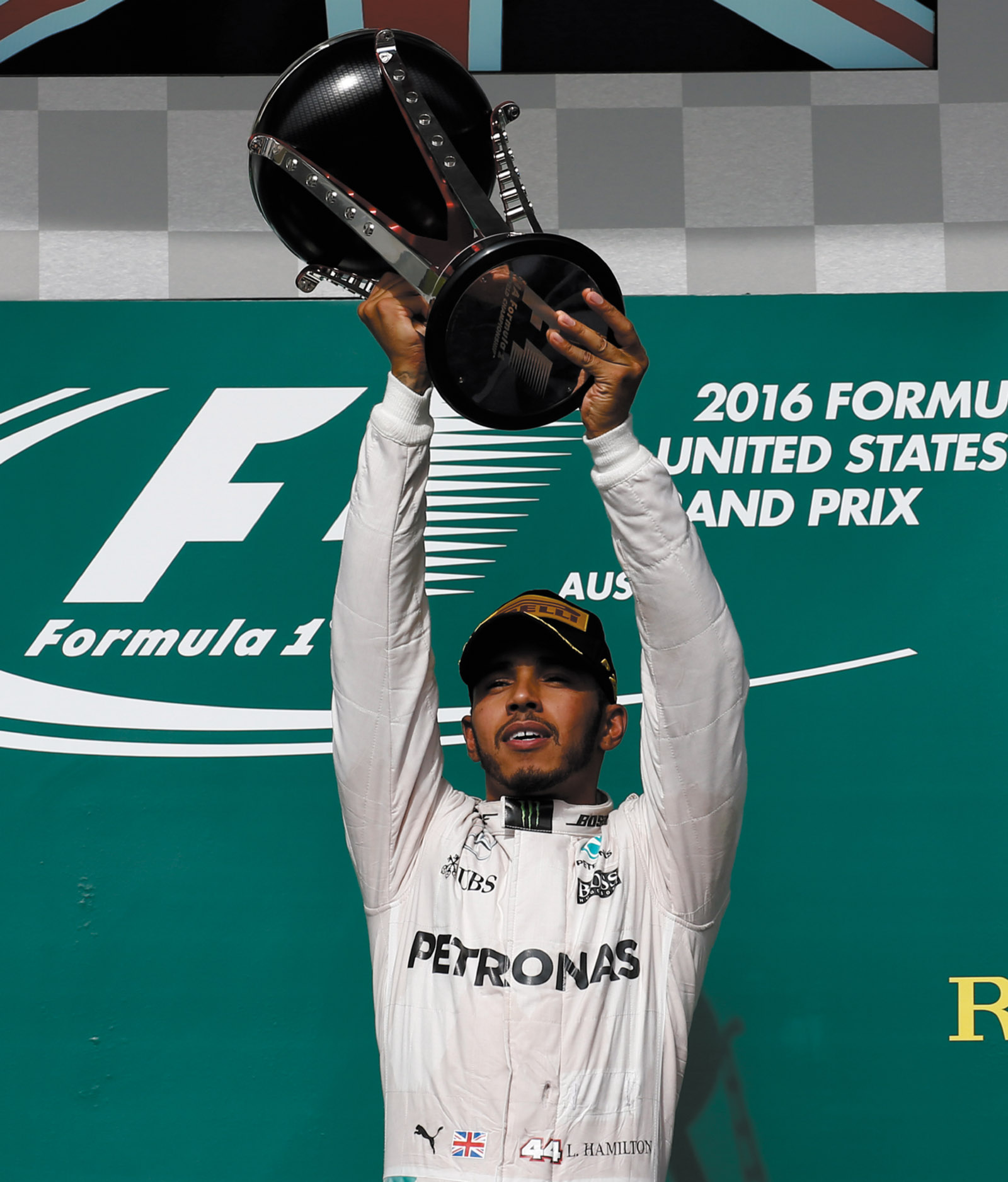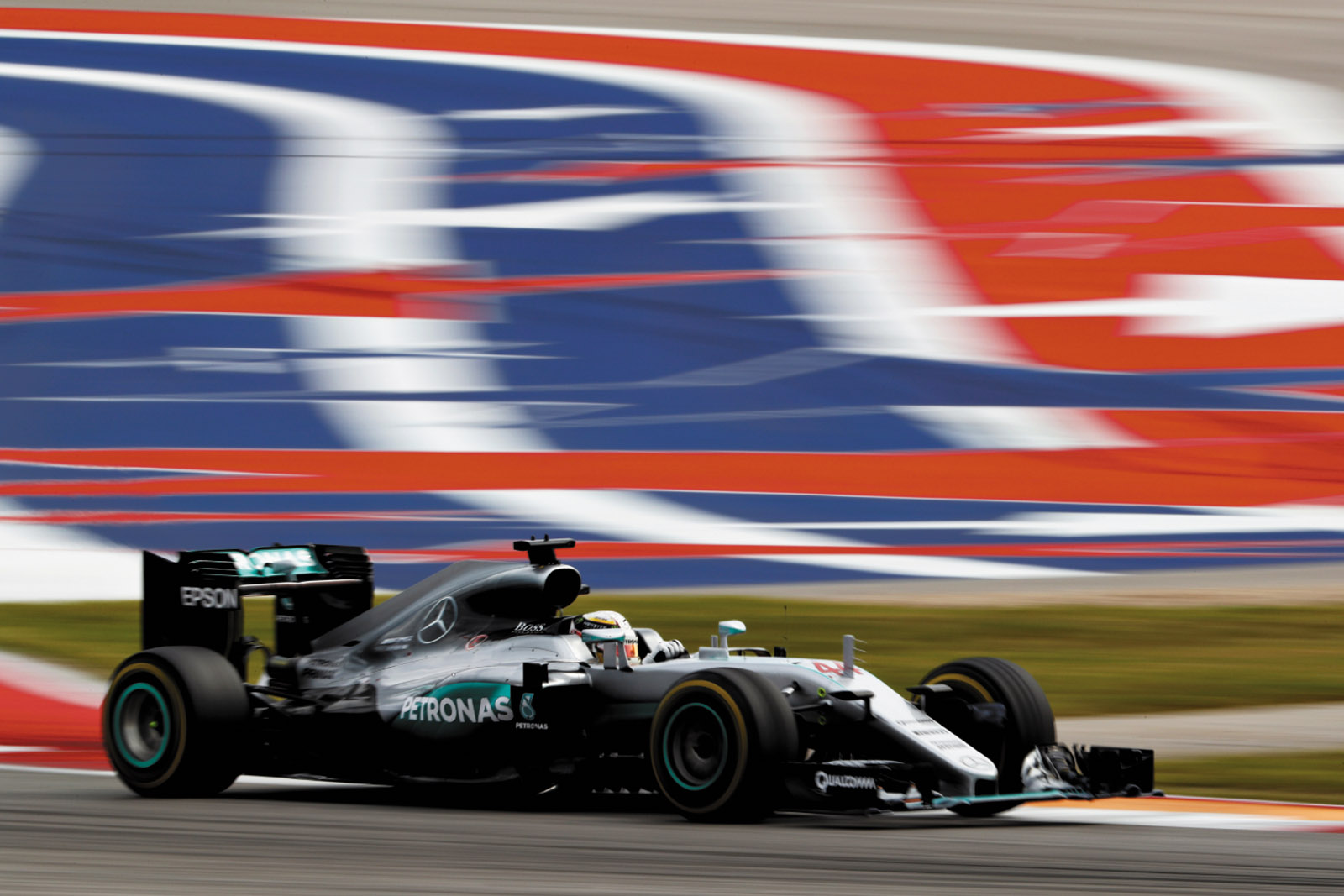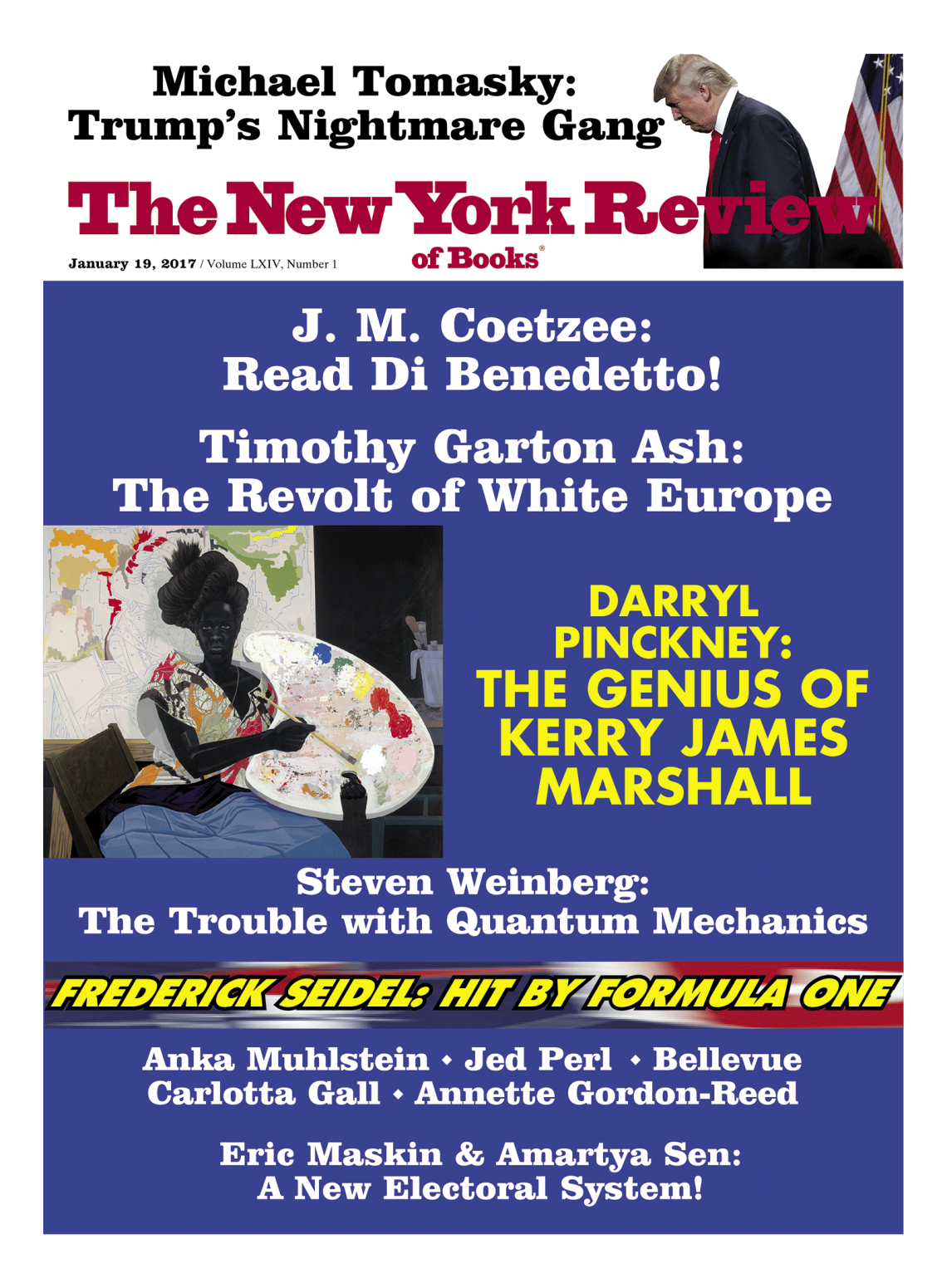The crowd jumps to its feet, whooping and clapping. Finally! The cars are coming onto the track. The bright blue guileless Texas sky looks down on a festive gaiety of matching baseball caps on girlfriends and boyfriends, wives and husbands, plump kids and lean kids, white and whiter—almost no African-Americans—friendly good spirits effervescing in the American air! The baseball caps are festooned with the names of factory teams: Red Bull! Ferrari! Toro Rosso! McLaren! We are in Texas and Texas is everywhere and everywhere does not stop!
This is the Circuit of the Americas, known as COTA, a half-hour outside Austin and very near the airport, and this is a Formula One auto race, one of the last in the season of F1 races around the world, the previous one having taken place in Japan, and before that Malaysia, and before that Singapore, and before that Italy—and the next, a week from now at the end of October, taking place in Mexico—a competition starting at the end of March in Australia and ending at the end of November in Abu Dhabi. The world!
Across the way, on the far side of the track, in the garages, surgical severity and concentration surround the race cars as they are fussed over and pushed out into the pit lane like patients in wheelchairs being wheeled out of their rooms by hospital staff. Crowd noise, shouts of happiness, vendors’ shouts of “Beer here!”—while the cars glide in silence, two mechanics at each end pushing them to their assigned spots on the track, the precise location determined by how quickly the car got around the track in time trials that took place yesterday, the fastest car occupying the front row “pole position,” which gives the driver an advantage at the start of the race, the other cars, two by two, lined up in the order of their time-trial times.
There is the sudden explosive shriek of a power gun securing lug nuts to wheels on a car still in the garage. The external starter motor is attached to another car and its engine coughs and then screams and then roars. These are brightly colored centipedes on four wheels, low to the ground and long, long in relation to their height, slender katydids, the driver enveloped, hidden almost entirely, helmeted head, hands on the small steering wheel. You watch from your seat in the stadium, but you see better by looking at one of the big TV screens embedded in the wall opposite on the other side of the track.
The cars are in position now. The race is about to start. Now the noise from the revving engines, preparing to do their thing, is rising to a higher pitch, though still far short of the shattering, hilarious, superb noise of the previous generation of F1 cars, which under new rules got tamped down out of a perhaps mistaken belief that the public would prefer less noise from the race cars. Many people, and especially Bernie Ecclestone, the billionaire British generalissimo of F1, the Sun King, the duce of the F1 business group, think otherwise. More noise, more excitement, more fans, more profit! They want the old deafening sound back. (There had been a race earlier of historical race cars, cars legal before the new sound rules, so you had a chance to blow out your ear drums.)
Ready, set, liftoff! Earplugs recommended—volunteers are distributing them to the crowd for free, little orange ones that you roll between your fingers before inserting them, which are not nearly as effective as the earmuff plastic sound suppressors that cover the entire ear, which the pit crews use. Even with the sound abatement, liftoff equals blastoff, equals lots of noise!
This is a most peculiar spectator sport, as it will turn out, since from your excellent and expensive seat you will see the cars flash by whoosh whoosh, scream, scream, scream, for a few seconds, a blur of race cars, and otherwise you will follow the cars and their progress by watching the TV and trying to hear the commentators over the crowd noise and car noise. The cars flash past and then climb the hill to the first turn. You crane your head around to watch whoosh whoosh and then they’re gone till they complete the circuit, a couple of minutes, and then flash past again.
This happens over and over. For nearly two hours. Fifty-six laps. Each lap: 3.426 miles (5.513 km). Race distance: 191.63 miles (308.405 km). Maximum speed reached: 206.92 mph (333 kph). Lap record: 1:39.347 (by Sebastian Vettel in 2012). And that’s the race. You see from the sign above the TV screen, and—when you can hear—you hear from the commentators, that the drivers’ positions in relation to each other change, who’s in first position, second, and so on, and occasionally on the TV you see an attempt, successful or not, by one driver to push his way past another—but that’s occasionally. A most peculiar spectator sport.
Advertisement
Formula One is the aristocrat of automobile racing, the top hat, the top. A man in the men’s room at COTA said to a friend as they washed their hands: “I’m devoted to the redneck roar of NASCAR cars but the sound of Formula One is winning me over. Loud but not as loud, and it’s thinner, higher, more refined, and I’m getting used to it, getting to like it.” Sounding quite refined himself.
There are many kinds of car races, needless to say, racing of all kinds being an activity natural to man, and cars being a language many people speak. There is the all-American favorite, NASCAR, in which automobiles that look like the cars you can buy in a showroom, with fenders, race around oval tracks crashing into one another, on purpose or not, and surviving to win or lose. This kind at COTA, Formula One, is sometimes called open-wheel racing, meaning the wheels and tires are not covered by any sort of fender but are exposed. The single-seat cars that race at the Indianapolis 500 are open-wheel also but not the same as these princely grandees, the rules and technical specifics different. Formula One cars are much more expensive to create, famously, fabulously, expensive, and finer creatures in almost every other way, and each unique, each distinct, their engines uniquely Mercedes or Ferrari or whatever, whereas Indy cars use “spec engines” supplied by a few manufacturers to all the race teams. Each F1 factory spends up to $400 million a year on cars and the team that prepares them and races them. It’s been alleged that each car is worth as much as $3 million just for the materials used, never mind the science and art part, and the actual making of it.
The race cars are objects of fascination, and awe even, but the drivers are the movie stars and earn movie-star money from their salaries plus what they make from endorsing products and from various corporate sponsors. It may seem odd to look at sporting events from the point of view of the financial gains and costs. It dislocates one’s sense of the glamour and thrill. The money part is estranging. Or maybe it isn’t; maybe it’s part of the carnival of fun. The carnival of glory and danger. Of course the money is part of the glamour and thrill!
The cramped cockpit of the race cars—with a dashboard of lights and switches and buttons that could fly a fighter jet—is barricaded with protection of the helmeted driver (almost always men), a fire-retardant cap under his helmet, a fire-retardant suit on his body, and a head and neck support (HANS) device. It’s an entourage of materials and design that will do their best when things go wrong. Crashes happen. Drivers survive them. The circuits have runoff areas and special walls and fences to help the cars slow and stop without disintegrating, or let them disintegrate piece by piece in speeded-up slow-motion, dispersing the energy of the crash. The drivers walk away from the crashes. Except when they don’t. Bernie Ecclestone says that an ambulance out on the track is essential because it excites the crowd and is a splendid sales device.
Hey, how is it there are no foreigners in the crowd here? Italy, France, Germany, Mexico—you don’t hear foreign languages being spoken. These Caucasians are people who are probably going to vote for Trump in a little less than three weeks’ time. The hotels in Austin are packed with citizens paying outrageous amounts for a room during the overbooked F1 weekend. Austin itself is a liberal lefty town of the young and the very young, a bustling college barbecue-and-bar town with bar bands blasting their desperate joy out into the warm streets where a certain number of homeless beg and sprawl along with druggies. Then there are the tourists who roam and gawk and go to the bars.
The barbecue is famous, and in one instance, at Franklin’s, the most renowned of the places, may require a wait of three or four hours to get what you’ve come for, the best brisket in Texas. Fans line up at 9:00 in the morning. Or earlier. The line goes on forever, just like Texas.
Now, you either care about speed or you don’t. Either beautiful machines going fast elevate your heart rate and stoke your mind or they don’t. Whether it’s motorcycles or cars, the factories that make these contraptions wrapped in carbon fiber skins that make them sculptures, and sculptures that travel at superluminous speeds, claim they do it for the technological developments that result from racing. We care about that but we don’t care. What we care about is that they go very fast. And they make noises that to us are beautiful, musical, and the machines themselves are beautiful, beauty that goes fast, not in the sense of evanescence, on the contrary, goes fast and does not fade, and goes fast and does not disappear. That’s a lot of wordplay. Let’s try it again, using motorcycles instead of race cars.
Advertisement
The Stradivarius
Of motorcycles lights up Via Borgospesso
As it flashes by, dumbfoundingly small.
Donatello by way of Brancusi, smoothed simplicity.
One hundred sixty-four miles an hour.
The Ducati 916 is a nightingale.
It sings to me more sweetly than Cole Porter.
Slender as a girl, aerodynamically clean.
Sudden as a shark.
In other words, art that goes fast.
In Cooper’s Old Time Pit Bar-B-Que, a barbecue place inexpensive enough to be crowded with students from nearby UT Austin, the University of Texas at Aus- tin, the bartenders are courteous, the bar is packed, by 8:00 in the evening there’s a line out into the street for the barbecue. Older guys are drinking shots at the bar. Kids at the long tables address immense piles of food they’ve just carried over on trays from the cafeteria-like serving station for the meats.
Nobody is talking about the impending election. Trump is coming but they don’t know it, even the ones who may wish it. And no one cares about the Formula One event taking place only a half-hour away. College football is on the TV. Two Texas college teams are battling. No one seems to care about the baseball World Series. The night outside is mild, the weather, day and night, unendingly pleasant. The Chicago Cubs will win their first World Series after 108 years. And Trump is coming!
Each factory team is allowed two drivers. The two for the Mercedes team are Nico Rosberg and Lewis Hamilton, a young German and a young Englishman of color, respectively number one and number two in the drivers’ competition this year so far. Hamilton is the greater driver of the two, perhaps by far the greater, but this year he has had a distressing number of mechanical problems to deal with in his race car, an almost uncanny number of breakdowns and mishaps of one kind or another. The complaint against Rosberg is that he is aloof. The complaint against Hamilton is that he whines and complains and that he’s full of himself and without charm.
Both men are good-looking. One oddity worth noting about the current drivers is that many of them are notably handsome. Then they get all that money. Then they get all that attention. But the attention they get is outside the United States because here the sport is barely known. There’s only the one F1 race in the United States, the one you’re seated at, at the Circuit of the Americas. That will change under the new management that will follow Bernie Ecclestone, who has been faulted for not pursuing and developing the market for Formula One in America.
Hamilton and Rosberg roar their silver cars up the steep hill to Turn 1, followed by all the other competitors, and turn left and disappear. And reappear on the TV screens. Silver is the traditional Mercedes race car color. For some, it may evoke the marvelous Mercedes and Auto-Union Grand Prix cars and their champion drivers in the years before World War II, otherwise known as the Nazi years.
Trump is coming.
Are there no foreigners here, no foreign languages? Actually, friend, there are Mexicans who have come up for the race, flying in, or driving here, whole families. How did you miss them? They crossed the border to get here.
Light-skinned Lewis Hamilton, whose grandparents came to England from Grenada, who loves America, loves Texas, loves California especially, will go on to win the Formula One race in Austin. White-as-snow Nico Rosberg will come in second but in the last race of the season at Abu Dhabi, a month from now, again coming in second behind Hamilton, will nevertheless have accumulated enough points to win the drivers championship. Mercedes, which has won the constructor’s prize since 2014, will win again.
Jimmie Johnson, in the last race of the NASCAR Sprint Cup Series in Miami, will come from behind and win a historic seventh Sprint Cup championship, joining Richard Petty and Dale Earnhardt Sr. as the only drivers to win more than four.
The Chicago Cubs will win it in the seventh and absolutely final game.
And Trump.
Postscriptum. Only days after he won the drivers’ championship in Abu Dhabi, Nico Rosberg, thirty-one years old, formally retired from Formula One racing, saying he had achieved his long-sought goal but had been under too much strain; it had been too hard to get there.




